Sandeel fishing consultation: review of scientific evidence
The review of scientific evidence that has been used to inform the development of proposals to close fishing for sandeel in all Scottish waters.
5 Marine Mammals
5.1 Diet
Sandeel are a key prey species for marine mammals in Scottish waters, comprising a large proportion of the diet of seals and some cetaceans (Pierce et al., 2004, Santos et al., 2004, Wilson & Hammond, 2019). However, the importance of sandeel to marine mammal diet varies considerably with species and season.
5.1.1 Seals
Grey seals (Halichoerus grypus) and harbour seals (Phoca vitulina) are largely sympatric within the UK, occupying similar ecological niches with some degree of regional spatial partitioning. This is marked by a notable overlap in diet throughout the UK populations where sandeel and large gadids are proportionally the most represented prey groups by weight, in both species (Brown et al., 2001; Hall et al., 1998; Pierce and Santos, 2003; Sharples et al. 2009; Tollit & Thompson, 1996; Wilson and Hammond, 2019). While assessing the UK populations as a whole reveals these striking overlaps in diet, it is important to note that there is considerable regional and seasonal variation both in species specific diet structure and regionally specific overlaps.
Scat analysis studies have concluded that sandeel dominate the diet of grey seals in all regions during autumn and winter except for the Inner Hebrides where gadids predominated (Wilson & Hammond, 2019). However, this dominance shifts to gadids and other benthic species during the spring and summer in Orkney and Shetland, and drops from 22.2% to 8% of the diet of grey seals in the inner Hebrides (Table 4). For harbour seals, sandeel were also dominant but with regional variation. In the Moray Firth, sandeel were dominant in harbour seal scats across all seasons. However, the data suggested that sandeel became less important in more southerly regions with flatfish and gadids predominating in south-east Scotland, the southern North Sea and the Inner Hebrides. In addition, harbour seals from the Outer Hebrides and Shetland preferred pelagic species with sandeel only representing 13.1% and 23.7% of the diet in these regions during the spring and summer months (Table 4). This prevalence does increase during autumn and winter in Shetland where sandeel become the preferred prey of harbour seals, representing 31.5% of their diet (Wilson & Hammond 2019).
| Region | Trend | Species evenness | Diet Composition | |||||||
|---|---|---|---|---|---|---|---|---|---|---|
| Pv | Hg | SS | AW | SS | AW | |||||
| Pv | Hg | Pv | Hg | Pv | Hg | Pv | Hg | |||
| Southern North Sea | ↗ | ↗ | H>L | H>L | Sandy benthic Flatfish |
Sandeel | Flatfish Gadid Sandy Benthic |
Sandeel Scorpion fish |
||
| SE Scotland | ↘ | ↗ | M>L | M>L | Sandeel Flatfish |
Sandeel | Flatfish Gadid |
Sandeel Gadid |
||
| Moray Firth | -- | ↗ | L=L | L=L | Sandeel | Sandeel | Sandeel | Sandeel | ||
| Orkney | ↘ | -- | L<M | M=M | Sandeel Gadid |
Gadid Sandeel Trisopterus |
Gadid Pelagic |
Sandeel Gadid |
||
| Shetland | ↘ | -- | M<H | M=M | Pelagic Gadid Sandeel |
Gadid Scorpion Fish |
Sandeel Gadid Pelagic |
Sandeel Gadid Sandy benthic |
||
| Outer Hebrides | ↘ | -- | M | M | Trisopterus Pelagic Gadid Scorpion fish |
Sandeel Gadid |
||||
| Inner Hebrides | -- | -- | H=H | H=H | Gadid Pelagic |
Gadid Sandy Benthic |
Gadid Pelagic Sandy benthic |
Gadid Sandeel Sandy Benthic |
||
Note: Trend is the population trajectory of seals in each region since 2000 (SCOS 2020): ↗ = population increasing, -- = population stable and ↘ = population declining. SS = spring/summer; AW = autumn/winter. Species evenness: H = high (PIE > 0.75), M = moderate (PIE = 0.3-0.75) and L = low (PIE < 0.3). Diet composition: prey groups are listed in order of dominance and include those that together comprise at least two-thirds of the diet, by weight. Strongly dominant prey groups (in bold) are defined as top ranked prey groups contributing > 45% to the diet and a greater % than the sum of prey groups ranked 2, 3 and 4. All instances of sandeels are highlighted in red, with instances of strong dominance of sandeels additionally emboldened and underlined for clarity. Blank cells indicate absence of data.
Wilson & Hammond (2019) suggested that the decline in harbour seal abundance in the North Sea may be linked to a reduction in sandeel stocks. Specifically, there appears to be a correlation between regional declines of sandeel stocks (northern and eastern Scotland) and the declining populations of harbour seals in eastern Scotland and Orkney, where sandeel dominate the diet of harbour seals. This relationship with sandeel stock levels was supported by findings that the diet of harbour seals appeared more diverse in areas where harbour seals are not in decline (West of Scotland). If sandeel are in short supply, it has been proposed that grey seals may out compete harbour seals thereby contributing to their decline given grey seal preference for sandeel in these regions (Wilson & Hammond 2019).
While the data collected by Wilson and Hammond (2019) provided a broad spatial resolution encompassing all seal management areas to varying degrees these data are up to 15 years old and may not reflect any changes in prey selection which have occurred since dramatic changes in seal population size and distributions have progressed (SCOS, 2021). However, there is currently no reason to believe that sandeels no longer form an important part of seal and porpoise diet.
5.1.2 Cetacean diet
Harbour porpoises (Phocoena phocoena) in Scottish waters have been found to feed predominately on whiting and sandeel (Santos & Pierce, 2003, Santos et al. 2004) with sandeel being particularly important during the spring and summer (Table 5; Santos et al., 2004). More recent diet data for harbour porpoise in the northern North Sea are unavailable. However, studies on stranded harbour porpoise in the southern North Sea (Leopold, 2015; Lambert, 2020) found gobies, gadids, clupeids and sandeel to be the main diet components.
| Species Group and species | Dutch North Sea | Scottish North Sea | ||||
|---|---|---|---|---|---|---|
| 1989-19951 n=62 | 2003-20102 n=76 | 2003-20133 n=229 | 2006-20144 n=826 | 1992-19961 n=72 | 1992-20035 n=188 | |
| Gobies | 6.4% | 36.6% | 22.1% | 20.5% | ||
| Gadidae | 85.9% | 36.5% | 54.2% | |||
| whiting | 78.4% | 25.4% | 42.3% | 43.6% | 53% | |
| haddock | 5.6% | |||||
| saithe | ||||||
| pollock | ||||||
| Atlantic cod | 3.3% | 5.2% | 4.4% | 3.8% | ||
| Clupeidae | 1.9% | 10.9% | ||||
| Atlantic herring | 5.9% | 4.6% | 3% | 1.3% | ||
| European sprat | 4.1% | 5.8% | ||||
| Sandeels | 2.8% | 11.1% | 18.1% | 41.1% | 25.6% | |
| Lesser sandeel | 13.2% | |||||
Note: Calculated according to the estimated proportion (by reconstructed biomass) that each prey contributed to the diet. The sample size of each study is reported as n. Numbers are not always reported to species level, in such instances, values are reported by species group. Grey highlighted numbers represent prey groups and species that contributed more than 5% of the total prey weight.
1(Santos 1998) 2(Jansen 2013) 3(Leopold et al. 2011) 4(Leopold 2015) 5(Santos et al. 2004)
A diet study on stomach contents of ten stranded minke whales (Balaenoptera acutorostrata) in Scotland showed that sandeel were the most important prey species and contributed two-thirds of the individual diet, by weight diet (Pierce et al., 2004). These findings have been supported by other studies in the wider North Sea region. For example, Olsen and Holst (2001) found sandeel to comprise 86.7% of the weight of the prey species found in the stomach contents of minke whales caught by Norwegian whalers in 1999. Windsland et al. (2007) further found that sandeel dominated the diet of minke whales caught in the North Sea, however the proportion of sandeel dominance appeared to change between years, with one year showing a complete absence of sandeel in favour of a dominance of mackerel. Further, the importance of sandeel appeared to diminish through the sampling years, which was suggested to be linked to the poorer availability of sandeels in contemporary years (Windsland et al. 2007).
Sandeel were present in a diet study of a small number of white beaked dolphins (Lagenorhynchus albirostris) (Santos et al., 1994) but gadids are thought to be the predominant prey items in the North Sea (Canning et al., 2008, Jansen et al., 2010). Sandeel are not thought to be a major component of the diet of bottlenose dolphins (Tursiops truncatus) (Santos et al., 2001).
Ultimately, cetacean diet studies focussing on Scottish territorial waters are limited both spatially and temporally, with the bulk of work focussing on opportunistic data from dead stranded animals and bycaught animals. This type of study has an inherent bias given stranded animals tend to skew towards specific demographics and can be biased towards animals that die closer to the coast. Basing diet information on animals in poor condition (evidenced by them dying), and individuals which focus more on prey species that bring them closer to the coast provides a biased interpretation of what the relative importance of prey species to the entire population is. This bias is supported in that diet studies have often identified a significant difference in diet composition between individuals with different causes of death and between stranded and live individuals (e.g. Santos et al 2004). It must also be noted that none of the studies focussed on Scottish waters above contain data more recent than 2014, with the most recent published data for porpoises being 20 years old. This highlights the need for more contemporary data to make reasonable inferences on the current importance of sandeel to cetaceans, and how potential fishery closures and fluctuations in sandeel availability may impact cetacean populations.
5.2 Distribution/overlap with sandeel
Scotland holds internationally important numbers of marine mammals with 17 different species regularly occurring in Scottish waters (Hague et al. 2020). These species can occur throughout the marine ecosystem, from shallow coastal waters to the deeper waters beyond the shelf edge. Several species include a seasonally dependant component of sandeel in their diet. Marine mammals are capable divers, with many species foraging on benthic and demersal prey species, thus able to target sandeel occupying different regions of the water column. Furthermore, while seals are constrained to haul out sites to varying degrees throughout the year, cetaceans are relatively free-ranging, able to follow migrating and shifting food stocks.
Only marine mammal species for which sandeel are known to form part of their diet are considered here; grey seal, harbour seal, harbour porpoise, minke whale and white-beaked dolphin. Specific information on the diet composition and importance of sandeel prey for these species is summarised above. The reference source used to identify spatial overlap of sandeel with marine mammal species is the probability of sandeel occurrence data from Langton et al. 2021. Any temporal variation in the predicted overlap (i.e., seasonal movements, breeding seasons etc.) are discussed for each species.
5.2.1 Grey seal
Grey seals occur around the entire Scottish coastline and are known to undertake long foraging trips to areas further offshore (Figure 30). In Scottish waters, grey seal at sea distribution is predominantly driven by the proximity to suitable haulout sites, with density scaling inversely with increasing distance from haulouts (Jones et al. 2015; Carter et al. 2020). However, grey seals often undertake foraging trips of hundreds of kilometres (e.g., Thompson et al. 1996). Further to haulout affinity, grey seal distribution has been statistically correlated with several other environmental covariates, however these vary regionally both in importance and in direction. For example, grey seal density in all regions apart from the Western Isles has been shown to be driven, to varying degrees, by sediment type, with most regions showing higher affinities for coarser sand and rocky sediments than finer sands and silt based substrates. This also mimics reported habitat preferences of sandeels in these regions (Holland et al. 2005). Contrastingly around the Western Isles, grey seals appear to be driven by a-biotic oceanographic processes such as sea-surface temperature, stratification and proximity to the shelf edge (Carter et al 2020). Additionally, the at-sea distribution of grey seals suggests particularly high use of offshore sandbanks in some areas (Carter et al. 2020; Jones et al. 2020).
The foraging ranges of grey seals vary greatly depending on the time of year. Individuals may remain close to haulouts during the breeding season (October-December), and as they are capital breeders (animals that use energy stores built up before reproduction to breed), the females do not forage during the lactation period.
Areas of high at-sea usage predicted by Carter et al. (2020) for grey seals include Orkney, areas of the east coast (particularly those around the Firth of Forth and Firth of Tay), and those along the shelf edge to the west of the Western Isles. The outer sandbanks in the Firth of Tay and the Moray Firth also appear to be favoured foraging grounds. Based on the probability of sandeel occurrence predicted by Langton et al. (2021), there will be significant spatial overlap in the waters around Orkney, the east coast, the Inner Moray Firth and the Inner Hebrides (particularly the waters north west of Islay).
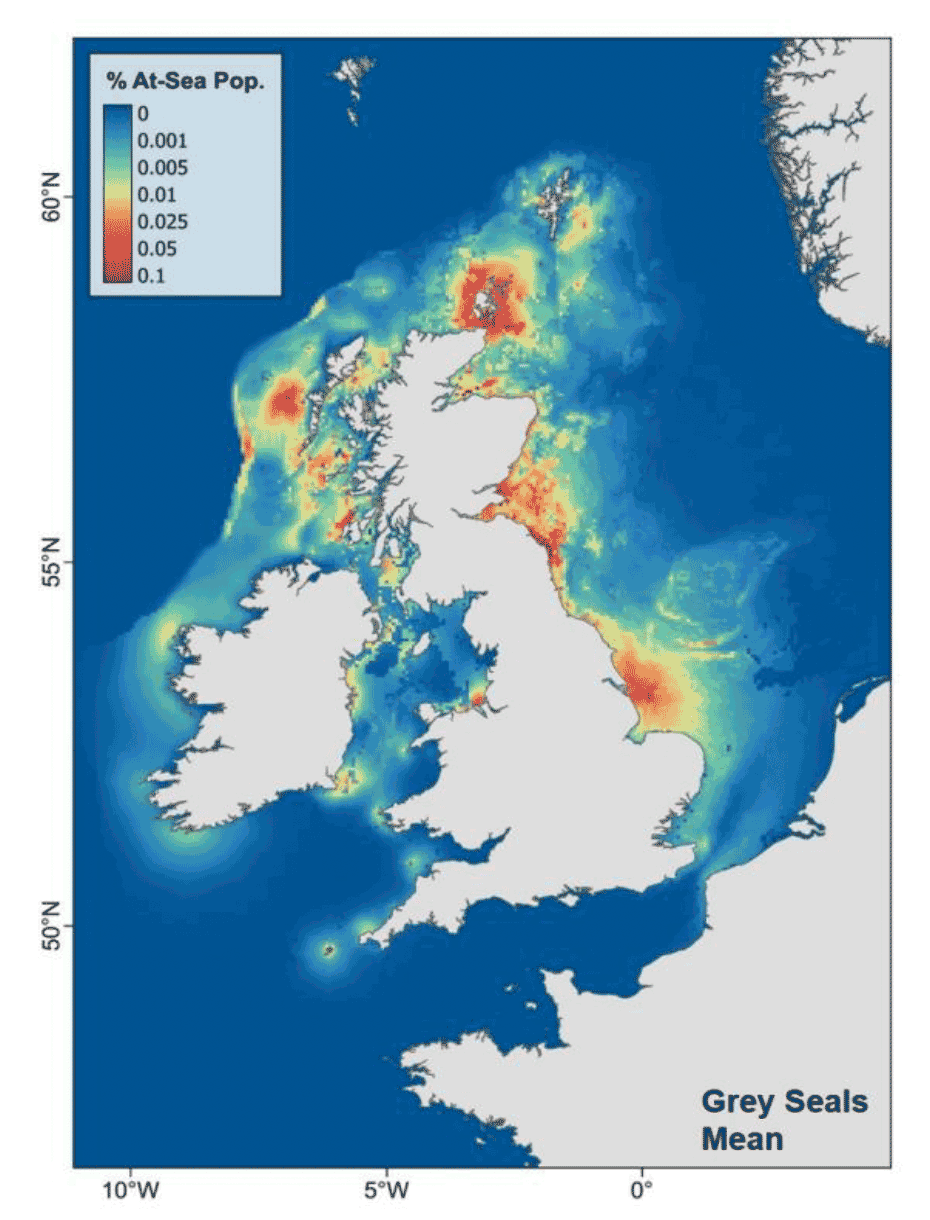
5.2.2 Harbour seal
Harbour seals usually remain closer to coastline than grey seals (Jones et al. 2015), typically undertaking foraging trips of up to 50km from their haulout sites (Figure 31; Thompson et al. 1996; Thompson and Miller 1990). However, foraging range can vary regionally and individuals from some populations are known to make longer trips offshore (Cunningham et al. 2008; Sharples et al. 2012). Harbour seals are occasional income breeders (i.e., females will sometimes continue to forage during lactation), undertaking sporadic foraging trips throughout the lactation period. This means that throughout their breeding season (June-July) harbour seals will still be predating sandeel.
The areas of overlap between sandeel and harbour seal populations in Scottish waters are primarily off the west coast. Harbour seal populations on the east and north coasts of Scotland have experienced severe declines in the last few decades. The highest predicted at-sea densities (and therefore, number of foraging individuals) of harbour seals occur throughout the Inner Hebrides, Orkney, Shetland and the Inner Moray Firth (Carter et al. 2020). The areas of high probability of sandeel occurrence from Langton et al. 2021 that are therefore most relevant to harbour seal are the waters of the Sea of the Hebrides, the Western Isles and Orkney.
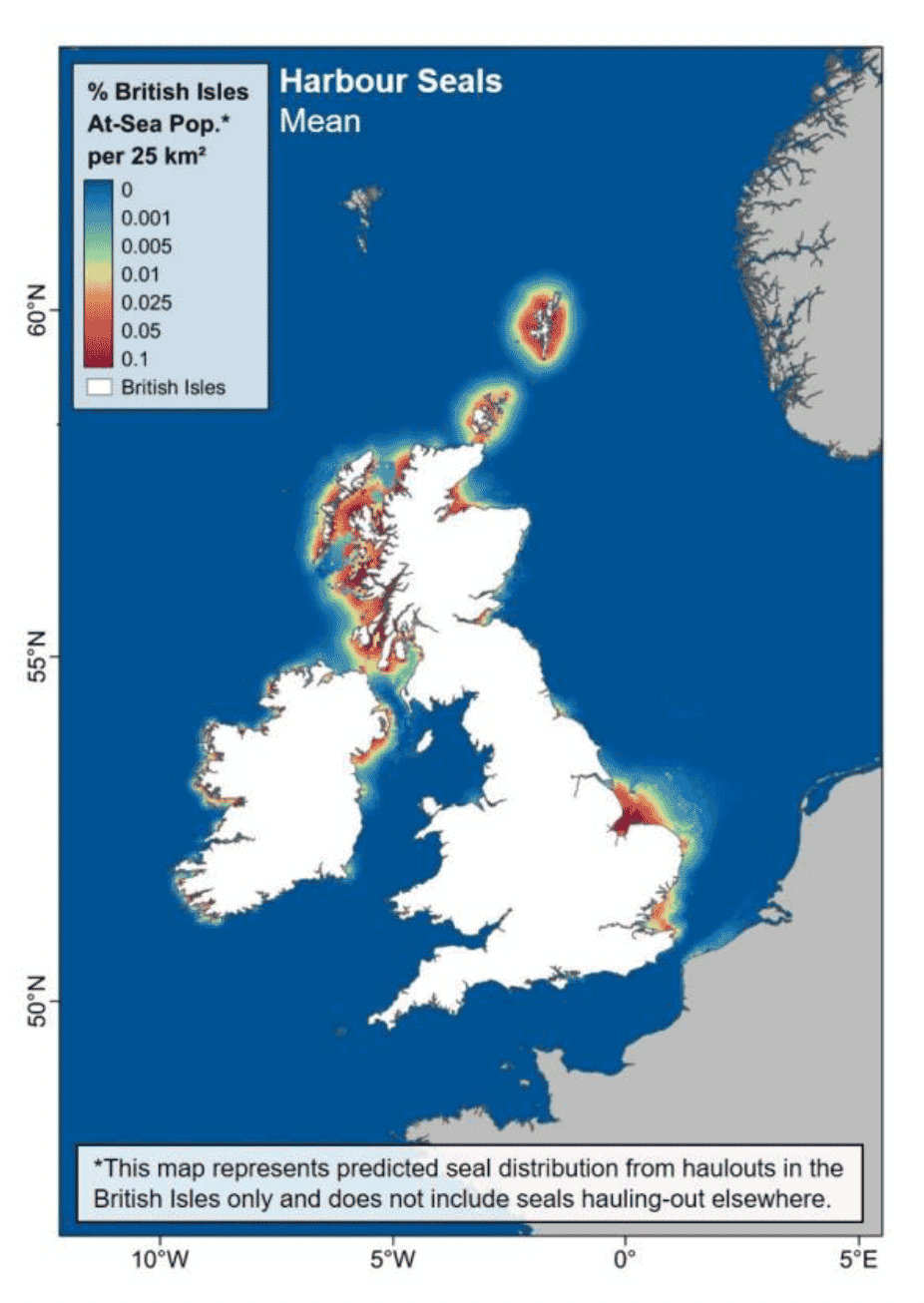
5.2.3 Harbour porpoise
Harbour porpoises are resident and abundant year-round in all regions of Scottish waters (Figure 32; Hague et al. 2020). Predictive habitat modelling based on data collected on the west coast shows a distinctly inshore distribution, with a preference for areas within 15km of the shore and depths between 50-150m (Booth et al. 2013; Marubini et al. 2009). Harbour porpoise distribution is also thought to vary with season in some areas across the UK, with animals predicted to move into the innermost North Sea during winter months from offshore areas (Figure 32 and Figure 33) Waggitt et al. 2020).
The highest observed densities of harbour porpoise in Scotland are generally in the North Sea (Lacey et al. 2021), where porpoises seem to prefer similar depth ranges as on the west, as well as sandy habitats that are typically favoured by sandeels, such as the gravelly sand seabed area of Smith Bank in the middle of the Moray Firth (Brookes et al., 2013, Williamson et al. 2016). It should be noted that the Inner Hebrides and Minches SAC on the west coast is designated for harbour porpoise, which coincides with areas identified as high probability of sandeel occurrence by Langton et al 2021. In terms of spatial overlap, the areas of high probability of sandeel occurrence that coincide with areas of high area usage by porpoise are the east coast, particularly the offshore regions adjacent to the Firths of Forth and Tay such as Scalp Bank, the waters to the north east of Islay. However, sandeel spatial overlap with porpoises should be expected in any areas of shallow, coastal water and for most areas of the North Sea wherever sandeel are present. Additionally, for most coastal areas in Scotland, harbour porpoise abundance may increase during the summer months which is coincident with the seasonal increase in sandeel in the water column suggesting a possible link with seasonal movement of porpoises and availability of sandeel.
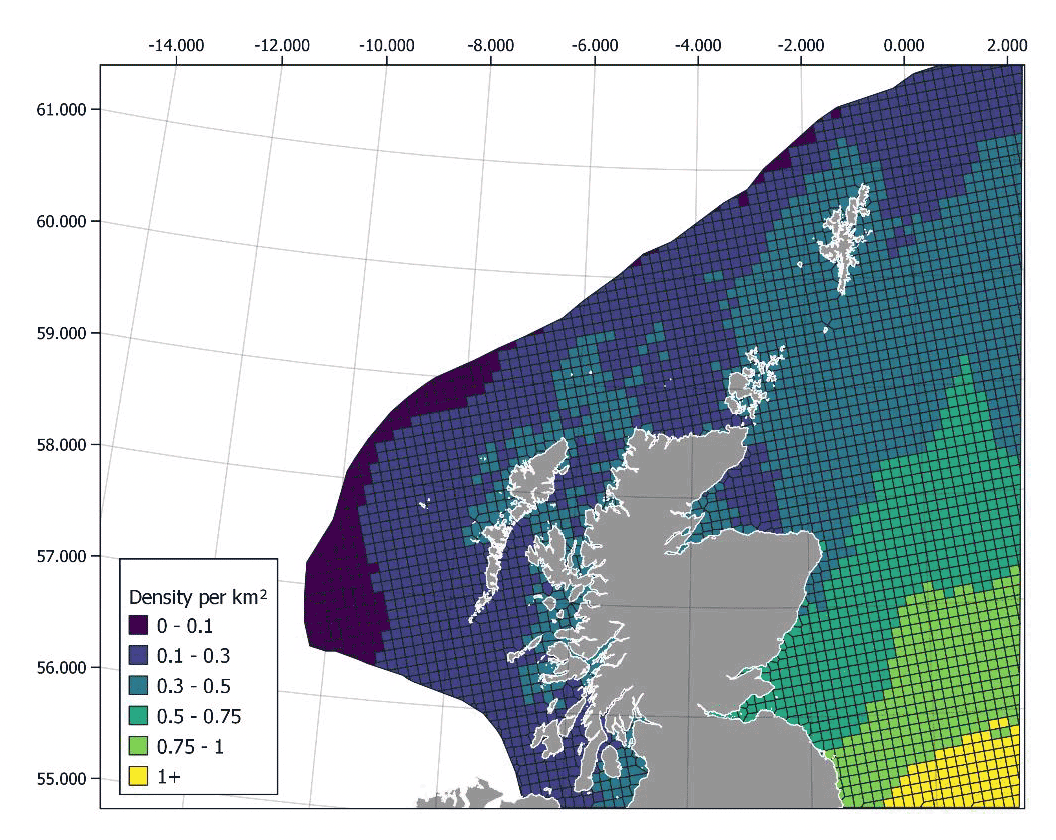
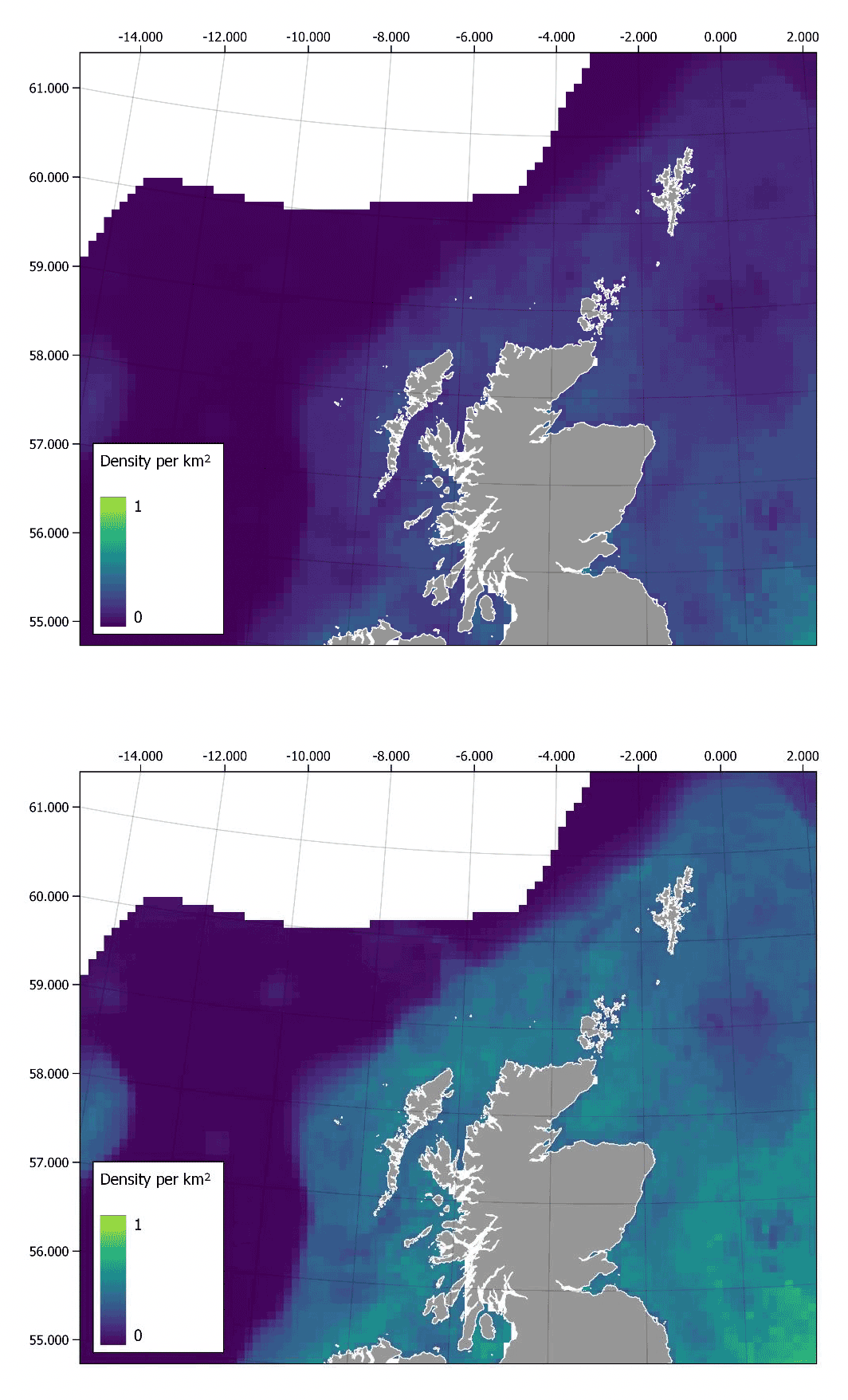
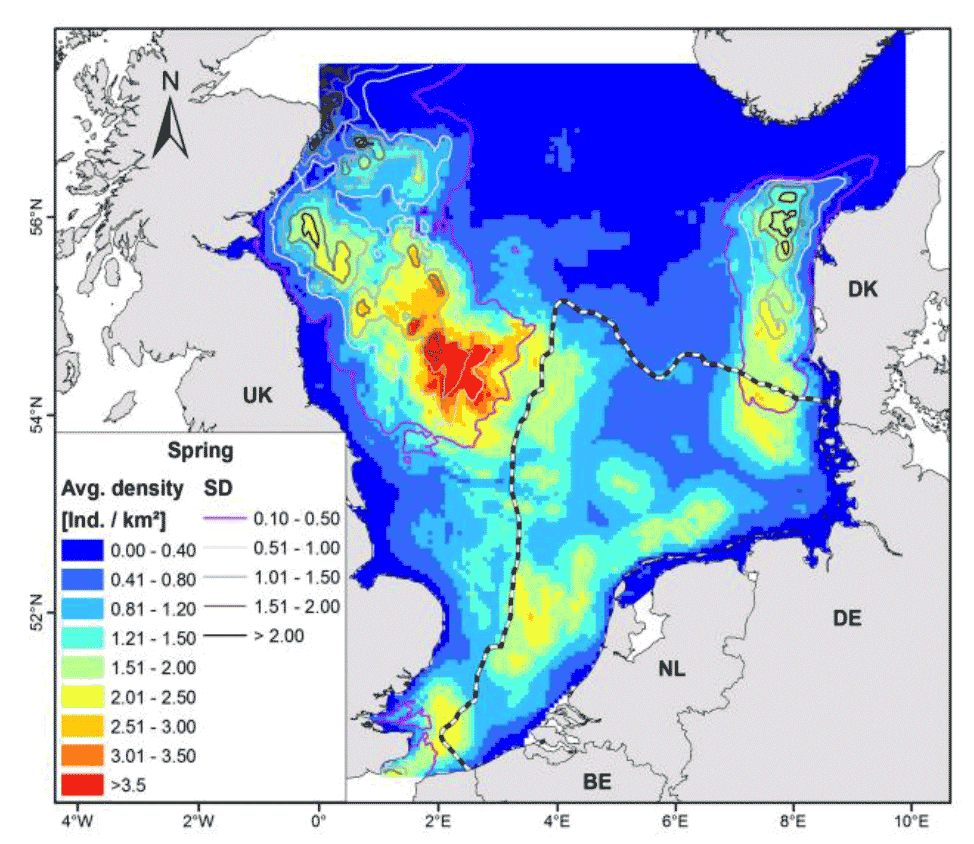
5.2.4 Minke whale
Minke whale distribution in Scottish waters is not well understood. Different studies, using different survey methods, suggest different high usage areas. In some areas there appears to be year-round occurrence, whereas for most areas minke whales are present only in the summer months (Figure 35 and Figure 36; Hague et al. 2020). Minke whale occurrence is associated with sea surface temperatures and chlorophyll concentrations (Figure 37; Paxton et al. 2014). As such, temporal and spatial variations in minke whale distribution are to be expected both within and between years.
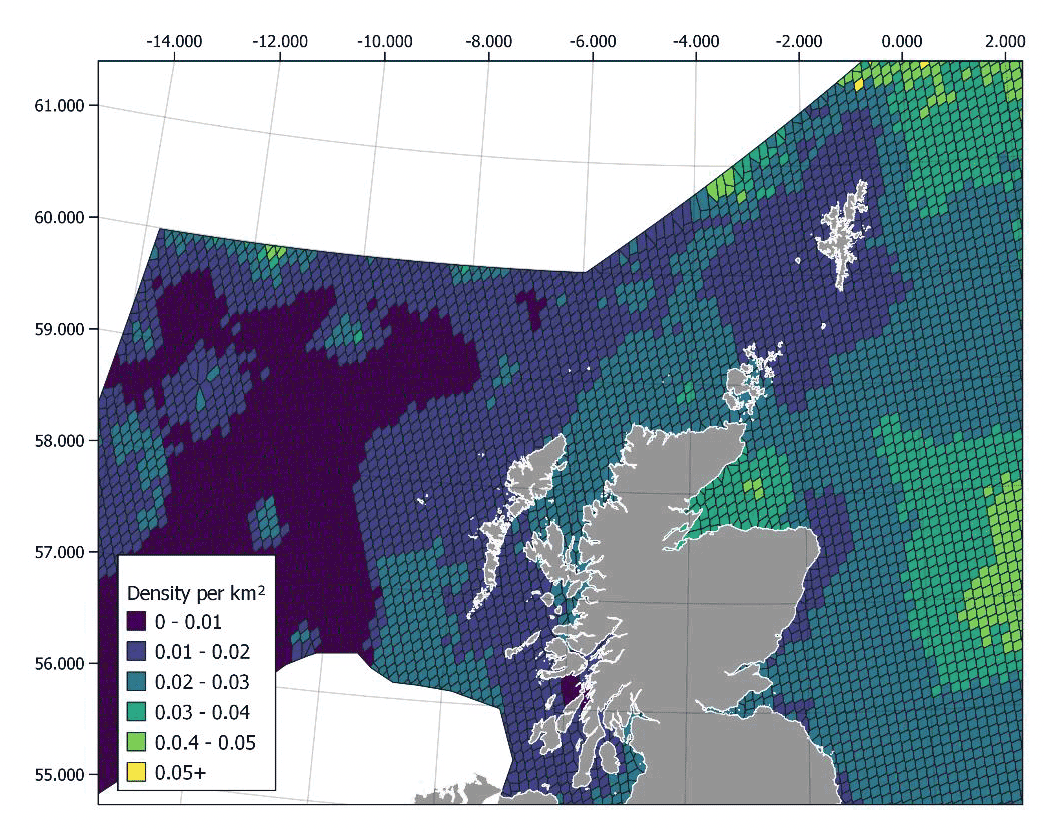
In summer, high use minke whale areas appear to be the Moray Firth, the waters north of Shetland and the entire west coast of Scotland. This is spatially coincident with identified sandeel hotspots in Scottish waters (Langton et al. 2021) and may reflect movement of minke whales targeting sandeel as they become more abundant in the water column during the summer months. This relationship would be particularly important for filter and lunge feeders such as minke whales given their foraging behaviour predominantly and generally targets small actively swimming (nektonic) species. As density of a pelagic prey species increases it would follow that density of filter and lunge feeding species would also increase. The Minches, the Sea of the Hebrides and off the west coast of the Western Isles are also known to experience seasonally varying hotspots of minke whales (Figure 34) While the identified hotspots are not coincident with relatively high sandeel abundances on the west coast (Langton et al. 2021) this may indicate variation in diet between spatially discrete populations of Minke whales; a pattern seen in other, more studied marine mammals, as described above.
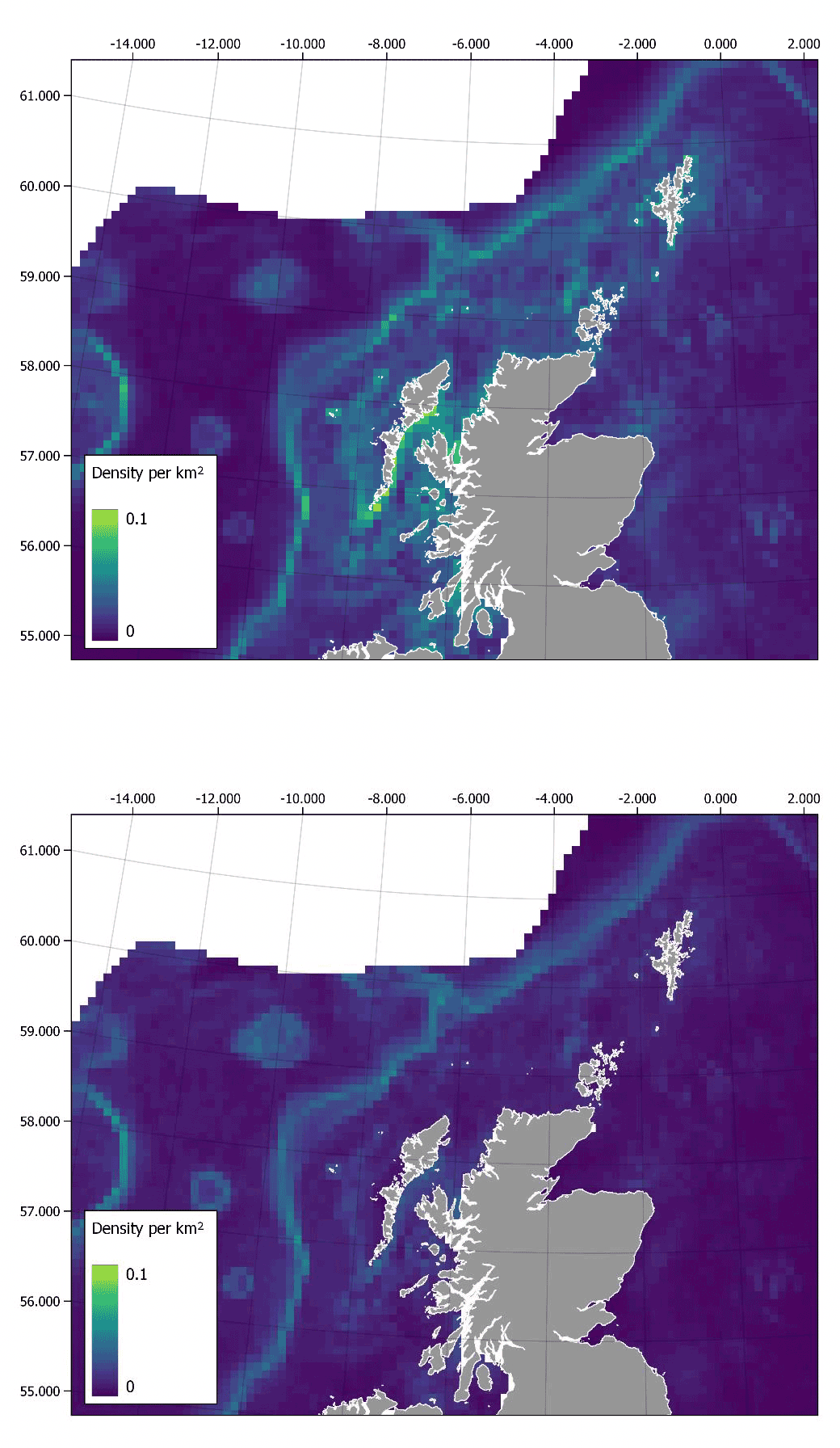
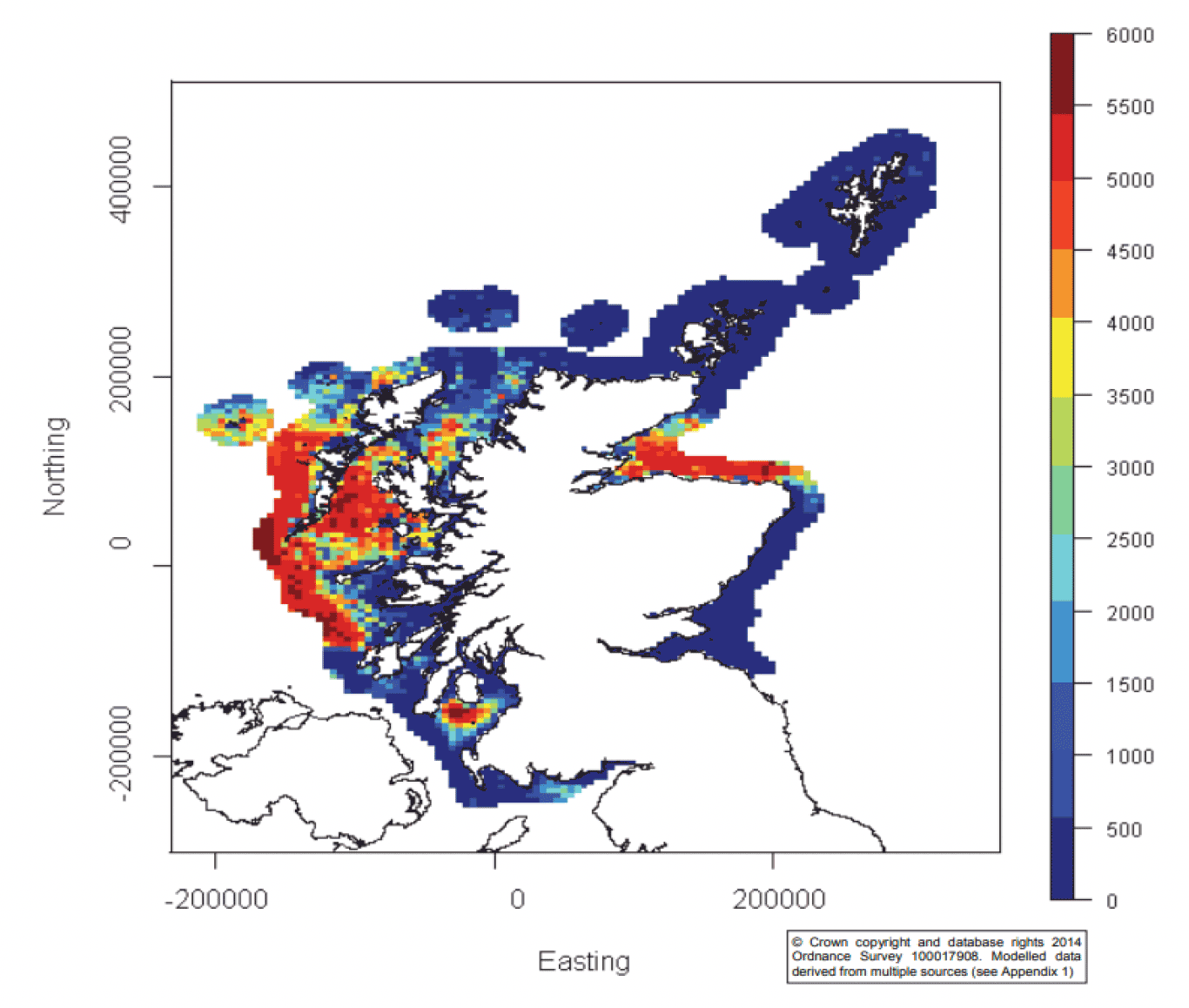
5.2.5 White-beaked dolphin
White-beaked dolphins are present in Scottish waters year-round, with a wide distribution that favours both offshore and nearshore areas depending on the region (Figure 38) The presence of white-beaked dolphins has been found to be influenced by slope angle, with individuals appearing to favour areas of slope (Canning et al. 2008) and sections of coast adjacent to deeper water (Weir et al. 2007). The abundance of this species in nearshore waters appears to vary seasonally (Weir et al. 2007), with numbers increasing in the summer months as more individuals move into the area from offshore (Waggitt et al. 2020).
White-beaked dolphins appear to be present in reasonably high numbers in all regions of Scotland except the south west and south east of Scotland (Figure 38 and Figure 39; Lacey et al. 2021). Distribution of white-beaked dolphin appears to change seasonally, with an apparent shift eastwards between winter and summer months, with densities in the North Sea peaking in June and July (Figure 39). The main areas of white-beaked dolphin overlap with high probability of sandeel occurrence is the offshore waters of the east coast, concurrent with increased sandeel availability in the water column during summer months where seasonal white-beaked dolphin density is also highest.
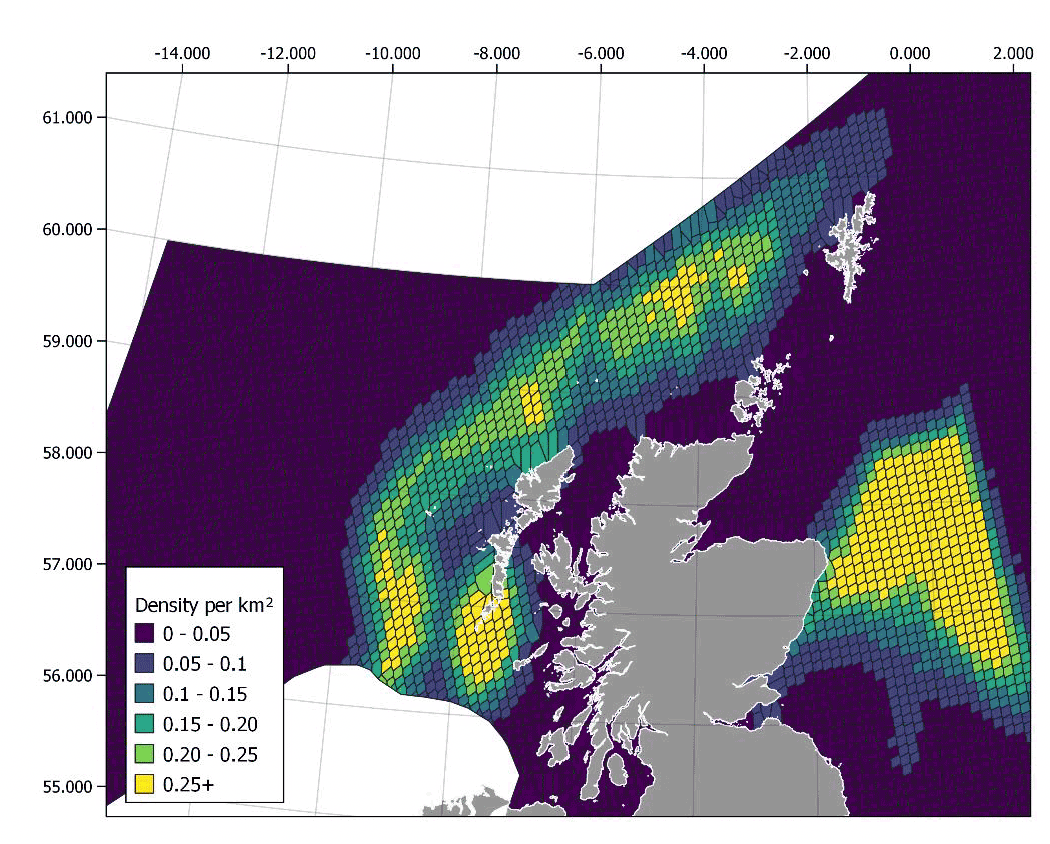
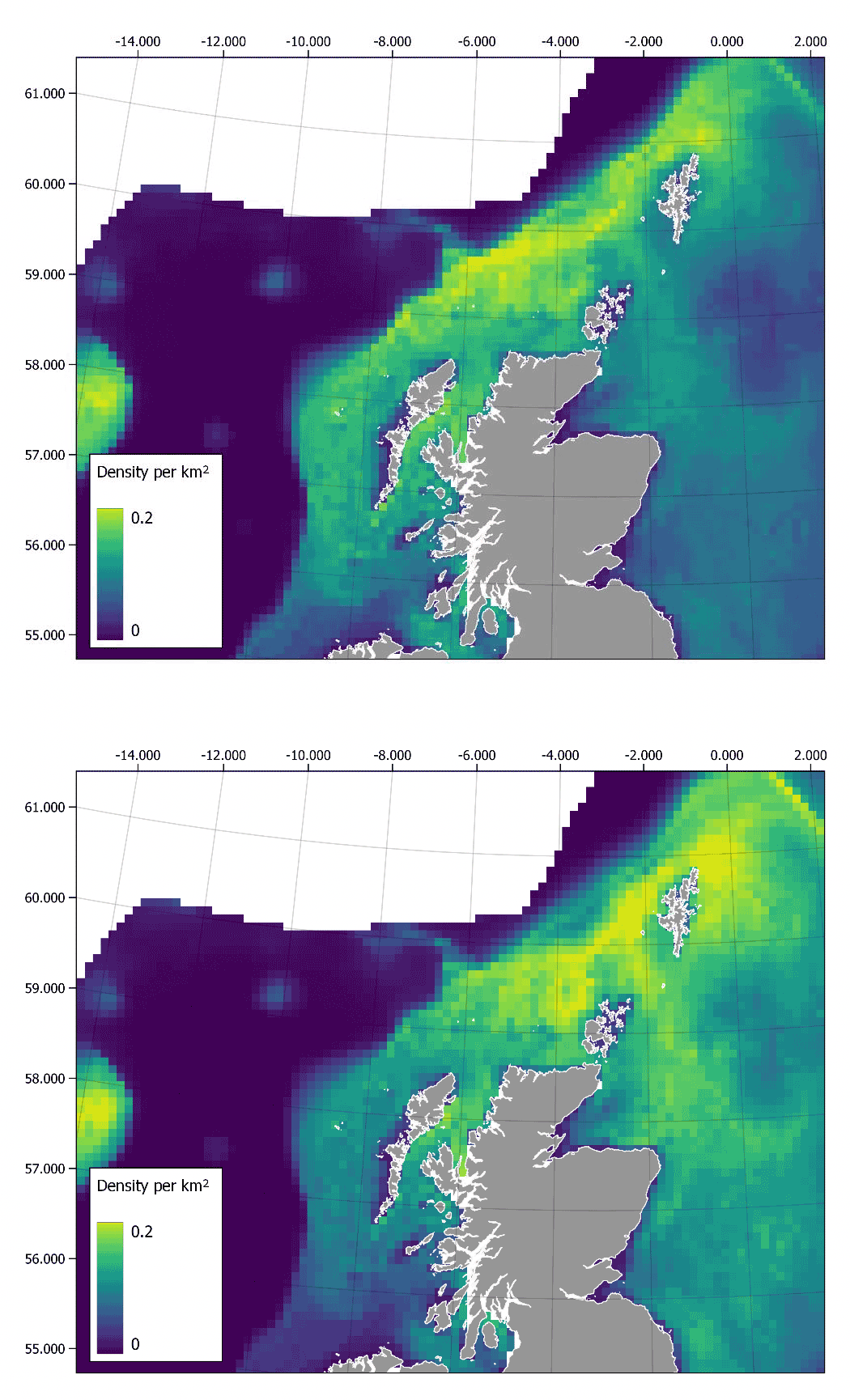
5.3 Vulnerability of marine mammals to declines in sandeel abundance
Sandeel are an abundant, but declining food source in much of the distributional ranges of the marine mammal species described above. However, the reliance on sandeel and subsequent susceptibility to fluctuations in sandeel abundance and distribution differ among marine mammal species, owing to variations in their ecological niches and dietary plasticity. Furthermore, the varying vulnerability of marine mammals to declines in sandeel abundance is a complex and stochastic interaction between prey distributions, diet, predator and prey demography, and predator foraging distributions and behaviour (Wilson & Hammond, 2019) so predictions are subject to considerable uncertainty.
Sandeel are a high-quality, lipid-rich prey source (Macleod et al., 2007) and improved body condition in marine mammals is linked to the proportion of sandeel in their diet. For example, Leopold et al. (2015) found a correlation between harbour porpoises in better body condition and higher amounts of fatty fish in their diet. Links between consumption of sandeel and health status of porpoises also suggested that a decrease in sandeel availability could have negative effects on porpoise populations (MacLeod et al. 2007). The predicted consumption of sandeel is high in porpoise diets, despite an abundance of other available prey species. Further, consumption of sandeel is significantly greater than all other prey types even when abundances are roughly equal (Ransijn et al. 2021). Multi-species functional responses have been published, describing the relationship between harbour porpoise and their prey species in the North Sea. These have indicated that when energy rich prey-species (i.e., sandeel) are scarce, porpoises must increase the total biomass consumed to avoid shortfalls in energy intake (Ransijn.et al. 2021) and by extension, poor body condition. As a result, minor differences in overall biomass and energetic intake were predicted between 2011 and 2022 (a period of pronounced sandeel decline in abundance across their range). Porpoise may subsequently travel greater distances or shift their ranges in search of a higher biomass of prey or increased densities of other high energy prey, partially explaining the southward distributional shifts of porpoise in the North Sea between 1994 and 2005 when sandeel in the SA4 region also showed pronounced declines (Figure 10, section 3.3.2; Hammond et al. 2005; Mahfouz et al., 2017).
Declines in sandeel stocks could have implications on inter-specific competition between marine mammal species in situations where sandeel are the primary food source. If sandeel are scarce, the considerable overlap in diet between grey and harbour seals (Wilson and Hammond, 2019) could result in exploitative competition which could impact one or both species. With harbour seals noted to be in significant decline in certain regions of Scotland, a depletion in sandeel stocks could be a factor in the further decline of harbour seals as indicated by the continuing decline in areas where seals show high preference for sandeels and little plasticity in diet (Wilson and Hammond 2019). The compounded effects could hasten the decline in certain populations, rendering conservation effort increasingly challenging (Hanson et al. 2015).
5.4 Summary of Evidence on Marine Mammals and Sandeel
As noted in section 3, identifying an effect of the sandeel fishery or a reduction in fishing pressure is difficult as it involves complex interactions between multiple drivers of both sandeel and predator dynamics. Further, data on the effects of sandeel abundance on marine mammal population sizes, foraging ecology and distribution are limited, with few studies able to garner sufficient statistical power to identify significant relationships. However, it seems a reasonable assumption that any increase in sandeel abundance that might result from a reduction in fisheries pressure might be beneficial to several populations of marine mammals given their dependence on sandeel as a prey source.
Contact
Email: sandeelconsultation@gov.scot
There is a problem
Thanks for your feedback